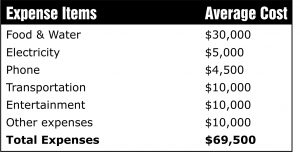Today’s article is particularly inspired by the ongoing negotiations between the Guyana Teachers’ Union and the Government of Guyana through the Education Ministry – with respect to the issue of salary increases for the teachers. The position of the national discussion and debates surrounding this matter is that teachers need a livable wage/salary.
The problem that is unique to Guyana, however, is that there is a lack of data compilation on a Cost of Living Index in particular – which should be an important data and/or indicator in order to guide or inform economic policy-making. For example, such data should be an important benchmark to set the level of minimum wage in Guyana – despite the fact that the Government really cannot directly control the drivers of rising cost of living. 
That said, the minimum wage in Guyana is $60,000. Nonetheless, using [2017] GDP per capita [income], which is about US$4,800, this works out to about US$400 per capita income on a monthly basis, which is equivalent to Gy$80,000. This can be interpreted as such: the average person in Guyana earns between $80,000 and $100,000 per month. Using this figure as a good benchmark, the table below shows the average cost of living expenditure per person (exclusive of rent if a person has to live out of a rented apartment, an expense a lot of persons do incur):
It should be noted that the above expenses are very conservative, because what if a person has to rent an apartment? The average rent is about $30,000. Other considerations or assumptions that were excluded from the above list are: electricity expenses tend to fluctuate, and there are unforeseen expenses as well. Notwithstanding, in applying the above illustrated average expenses of $69,500 to the average person’s income of about $80,000, it gives rise to a surplus for savings of $10,500. Clearly, a person under these conditional and practical assumptions cannot afford to do anything else; not even having access to credit.
The Consumer Price Index (CPI) – the measure of Inflation
Inflation can be defined as a sustained or continuous rise in the general price level; or, alternatively, as a sustained or continuous fall in the value of money. Given this definition, several things should be noted. Firstly, inflation refers to the movement in the general level of prices. It does not refer to changes in one price relative to other prices. Such changes are common, even when the overall level of prices is stable. Secondly, the prices are those of goods and services, not assets. And thirdly, the rise in the price level must be somewhat substantial and continue over a period longer than a day, week or month (Labonte, 2011).
The CPI is used for three basic purposes:
1. It is a measure of inflation experienced by consumers, and an important indicator of the condition of the economy.
2. It can be used to adjust other economic data for changes in price levels, and to convert into inflation – free dollars. For example, retail sales and income data are “deflated” to assess their “real” movements over time. Another example is to estimate changes in the purchasing power of a dollar.
3. Various government income programmes, such as Social Security, use the CPI to adjust payments or income eligibility levels.
While the CPI is used to calculate cost-of-living adjustments (COLA), the CPI in and of itself is not a cost-of-living index. It does not take into account changes in buying patterns that consumers make to adjust to relative price changes. Consumers usually react to relative price changes — for example, beef prices rising more than the price for chicken — by substituting less expensive alternatives for the more expensive commodities; that is, substituting chicken for beef. The CPI does not reflect short-run adjustments made in response to price changes as a cost-of-living index would.
Though the CPI can be used to “deflate” government revenue data, it should not be used to adjust government expenditure data for the effects of inflation. (To be continued next week).
